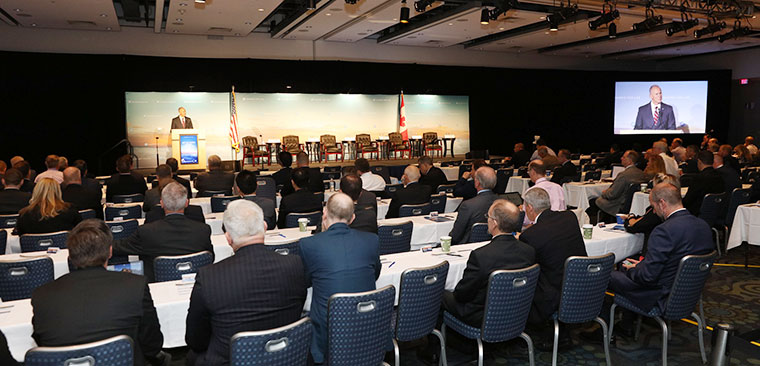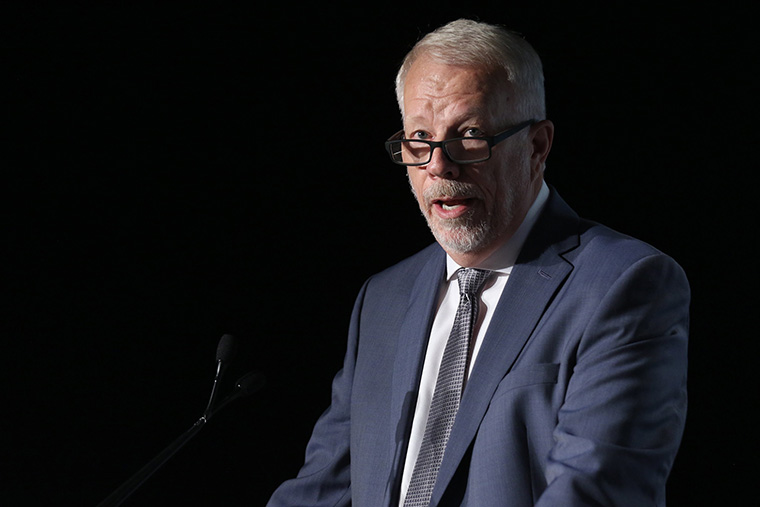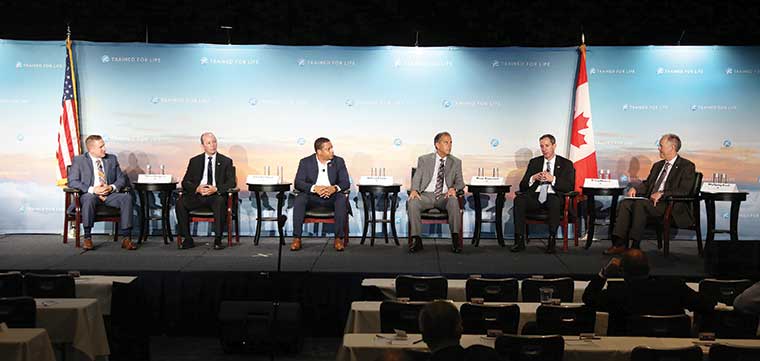Learning from History at ALPA's Air Safety Forum
By Kevin Cuddihy, Contributing Writer; Christopher Freeze, Senior Aviation Technical Writer; and John Perkinson, Senior Staff Writer

Capt. Joe DePete, ALPA’s president, highlights the Association’s history during the 65th Air Safety Forum.
The public day of ALPA’s 65th Air Safety Forum took place on July 18 with opening remarks from Capt. Joe DePete, ALPA’s president, highlighting the long history of safety work and the importance of continuing to honor that history.
“Learning from the danger that early aviators faced,” he said, “airline pilots have helped lead North America to safer skies today.” There has been loss along the way, DePete admitted, but “we’ve turned pain into progress.” And that progress continues. ALPA’s president reviewed the long list of successes the Association has achieved, noting, “It’s important to remember why the national airspace is so safe. We made it that way. You made it that way.” But he cautioned that work still remains.
Read on for more coverage of the forum’s public day and check out photos, highlights, and videos. Look for coverage of the private days of meetings, councils, and workshops in the September issue of Air Line Pilot.
DePete Welcomes Attendees
DePete opened the forum by talking about the 50th anniversary of the Apollo 11 moon mission and the trials and accomplishments of the North American aviation industry that helped make it possible. He referenced the Saturn V rocket’s smooth transition through national airspace to highlight the work the United States is currently undertaking to safely integrate commercial space operations and unmanned aircraft systems into the national airspace system. DePete also noted the Colgan Air Flight 3407 accident, acknowledging what the airline industry has learned from it and how that information has allowed the industry to advance safety.
“The airline industry has learned the value of applying scientific methods to what’s happened in the past, why accidents occur, and how to prevent them from happening again,” he told attendees. “But we didn’t stop there in our pursuit of safety. Now we also apply scientific methods to proactively influence what could happen in the future.”
Szwalek Talks Canadian Aviation
Following his remarks, DePete welcomed Joseph Szwalek, the associate director general of civil aviation for Transport Canada, who gave the morning keynote address, discussing current efforts to modernize Canadian aviation. He acknowledged the agency’s efforts to conduct the first real regulations review since 1996, efforts to address laser cockpit attacks, and ongoing work with fatigue risk management systems.
Throughout his presentation, Szwalek stressed the importance of air transportation industry collaboration. “Stakeholders’ views are essential in ensuring that Canada has a safe, competitive, thriving aviation industry,” he observed, adding that airline pilots have an important role to play in Canada’s operational decisions and regulatory framework.

Joseph Szwalek, associate director general for civil aviation at Transport Canada, speaking at the forum.
Clueless, Careless, or Criminal?
In the panel discussion titled “The Rogue Drone: The Threat Perspective,” pilots, industry stakeholders, and government officials discussed security issues, detection capabilities, how to educate the public, and how to mitigate risks.
“ALPA, industry, and the government have worked together well on safety-related issues regarding drones, but what about security?” asked Capt. Eric Herman (Sun Country), the panel moderator. “That’s the focus of our discussion.”
Angela Stubblefield, the FAA’s deputy associate administrator for security and hazardous materials safety, highlighted the agency’s four main areas of focus: remote identification, integration of detection technology into the airport environment, persistent risks, and counter-UAS technology. She discussed potential legal issues regarding detection and mitigation and cautioned, “The challenge is how the technology works in an airport environment.”
Craig Marech, the U.S. Secret Service assistant special agent in charge of special operations airspace security, provided a federal perspective to the panel. “Every incident that occurs around the world, we’re taking a look at it,” he said. “We’re investigating almost every technology out there” for the best ways to address the threat.
“The airport industry has been highly engaged with all of our partners on this issue,” stated Justin Barkowski, the American Association of Airport Executives vice president of regulatory affairs. He discussed legal and monetary concerns relating to detection and mitigation as well as the cost of disruptive drone activity.
Charlie Keegan, CEO of Aviation Management Associates, pointed out that prison facilities around the country have addressed similar concerns and urged the airline industry to work faster. He highlighted the importance of “detection, detection, detection” as the top priority.
F/O Orion Kingman (United) categorized theoretical runway incursions by drones as “clueless, careless, or criminal”—referring to the intent of the drone’s operator. “As pilots, we need to report any drone sighting,” he said, to fully understanding the breadth of the issue. He also highlighted the two types of security risks: a direct attack on an airplane and a disruption event meant to interrupt airport activities, like the one that occurred at London’s Gatwick Airport last year.
“The importance of finding the operator of a drone shouldn’t be understated,” said Stubblefield so that the “clueless” and “careless” can be educated. And as Kingman pointed out, “If we’re able to eliminate the clueless and careless from the airport environment, it’s easier to identify those with bad intent.”
Turbulence and Other Weather Events
Being able to effectively anticipate atmospheric turbulence and other weather phenomena during flight remains a serious concern for pilots. Capt. Don Dobias (United), ALPA’s Air Traffic Services Group chair, moderated a panel titled “Maximizing Meteorological Technologies: Opportunities for Improving Operational Planning and Decision Making.” The panelists discussed forecasting tools and strategies to identify and avoid these potentially dangerous encounters.
“Turbulence has caused more serious injuries to flight attendants and passengers than any other class of accident,” said Don Eick, the NTSB’s senior meteorologist. He noted that an average of 12 serious injuries occur each year due to turbulence and that 80 percent of the victims are flight attendants.
Dr. Weibke Deierling, a National Center for Atmospheric Research project scientist, outlined some of the turbulence prediction and detection technologies her organization has developed using super computers, research aircraft, sophisticated computer models, and extensive data sets. She also observed that PIREPS on weather conditions encountered during flight are particularly useful.
Randy Bass, a Weather Research Branch manager of the FAA’s NextGen Aviation Weather Division, explained how his agency aligns and manages weather research toward new concepts and capabilities that reduce the impact of weather in the national airspace system. He noted that the FAA has worked with other organizations to help develop radar-like capabilities using satellites to detect weather over oceans.
Ivan Rothmansky, a United Airlines flight dispatcher, emphasized that the ongoing communication between dispatchers and pilots during flight and the feedback pilots provide are crucial to safe operations.
Bradley Wilcko, an air traffic controller with the Southern California TRACON, talked about how his organization addresses weather while managing airport arrivals and departures. He remarked that air traffic controllers carefully monitor these routes for convective activity and turbulence.
Capt. Mark Eden (Frontier), a member of ALPA’s Air Traffic Services Group, acknowledged that weather planning has evolved during the many years he’s been flying, adding, “We now have more timely information available than we ever have.”
Chao Addresses Forum
U.S. Secretary of the Department of Transportation (DOT) Elaine L. Chao, who was the forum’s lunchtime keynote speaker, noted, “For decades, ALPA has been among the most valued, reliable, and important partners in helping the department achieve its safety mission.”
She discussed her organization’s priorities and how they’ve helped establish a safety record that’s second to none in the global aviation market. “As remarkable as the improvements in air safety have been, there’s always room for improvement, and the department will pursue every means, relentlessly, to accomplish this goal,” she said.
Chao also highlighted the ALPA-inspired “Check the Box” undeclared hazardous materials public-awareness campaign and examined the challenges associated with America’s growing commercial space sector.
“Working together, government agencies and the private sector are creating a regulatory framework that stresses safety but doesn’t hamper innovation,” said Chao. “This will help ensure that our country remains a global leader in transportation innovation.”

U.S. Transportation Secretary Elaine L. Chao addressing pilots and other stakeholders during the Air Safety Forum.
From the Ground Up
“Given the amount of time an airplane spends on the ground, safety while there will always remain a pressing issue,” said Capt. Jeff Sedin (United), who moderated the discussion titled “Aviation Safety from the Ground Level.” Panelists discussed current concerns in the industry, including differing levels of safety for passenger, cargo, and remote operations.
Tim Sampey, the Chicago Fire Department’s deputy fire commissioner of bureau operations, played a video of an aircraft rescue and firefighting (ARFF) response to an air carrier fire in 2016. He noted that the video showcased all the various parties—ATC, the flight crew, the cabin crew, the FBI, and ARFF—working together for a positive outcome. “One hundred and sixty-one people made it off of that aircraft, with zero fatalities,” he shared.
Capt. Rich Hughey (FedEx Express), the chair of ALPA’s President’s Committee for Cargo, reiterated that all pilots are cargo pilots. He examined the higher accident rate for cargo operations and delved into some of the contributing operational differences. Cargo and passenger operations, he said, use the same aircraft, often operate at the same airports, and use the same airspace. “However, the risk is different,” Hughey noted, “as cargo flights often operate widebody aircraft into smaller U.S. airports at night when air infrastructure is reduced, towers aren’t staffed, access to preferred runways is limited (due to airport/ILS maintenance or noise abatement), and ARFF personnel aren’t required to be on station at the airport. This is also the time when the risk of fatigue is elevated for both pilots and ground personnel.”
Jamie Melo, Transport Canada’s associate director of operations, pointed out that at remote Canadian airports there can be a lack of ARFF services, unpaved runways, and runways needing maintenance. He noted that Transport Canada may be able to provide funding depending on the information the agency receives from an airport.
Providing the airport perspective was Christopher Oswald, Airports Council International’s senior vice president of safety and regulatory affairs. “There’s work that needs to be done collaboratively, he said, “between airports and airlines to ramp up the levels of ground safety.” Oswald also discussed the collaborative partnership with the FAA and Transport Canada and highlighted past successes, such as addressing runway incursions.

Capt. Steve Jangelis (Delta), left, and Capt. Wolfgang Koch (Delta), right, moderate a panel discussion on prohibited airspace and modern airline operations.
Avoiding Airspace
In a panel discussion titled “Painting the Corners…Prohibited Airspace and Modern Airline Operations,” moderators Capt. Steve Jangelis (Delta), ALPA’s Aviation Safety chair, and Capt. Wolfgang Koch (Delta), ALPA’s Aviation Security chair, highlighted recent developments in protection and enforcement.
“As pilots, we’re ultimately responsible for remaining clear of prohibited airspace, but there are some emergency or safety-of-flight issues that can preclude that. Crews must communicate to ATC when that happens,” said Jangelis.
“Especially in and around Washington, D.C., it’s vital that we do everything we can to prevent these occurrences while maintaining safety,” Koch said, referencing Special Use Airspace Prohibited Area P-56 within the District of Columbia.
“Our mission is to protect the P-56 airspace; and earlier this year when two violations occurred within 15 minutes, we needed to investigate,” Marech remarked. “We’re allowed zero failures in our line of work, and the key to that task is learning what happened to figure out how to keep it from happening again.” He noted that ASAPs are a valuable safety reporting tool for such incidents and that “we aren’t looking to weaken them—but we have to react and learn to improve.”
Aubrey Farrar, an air traffic controller and National Air Traffic Controllers Association representative, advised pilots to “simply communicate to us any issues,” in the event of an inadvertent incursion into protected airspace such as a temporary flight restriction. “If you tell us what’s happening and you accidentally violate, we can explain what happened to anyone and keep things from escalating.”
Larry Lachance, NAV CANADA’s vice president of safety and quality, commented that Canada doesn’t have as many pop-up flight restrictions for certain politicians like the prime minister as other countries do. “While there are fewer opportunities to violate airspace,” he said, “we still take those violations just as seriously as other nations.”

